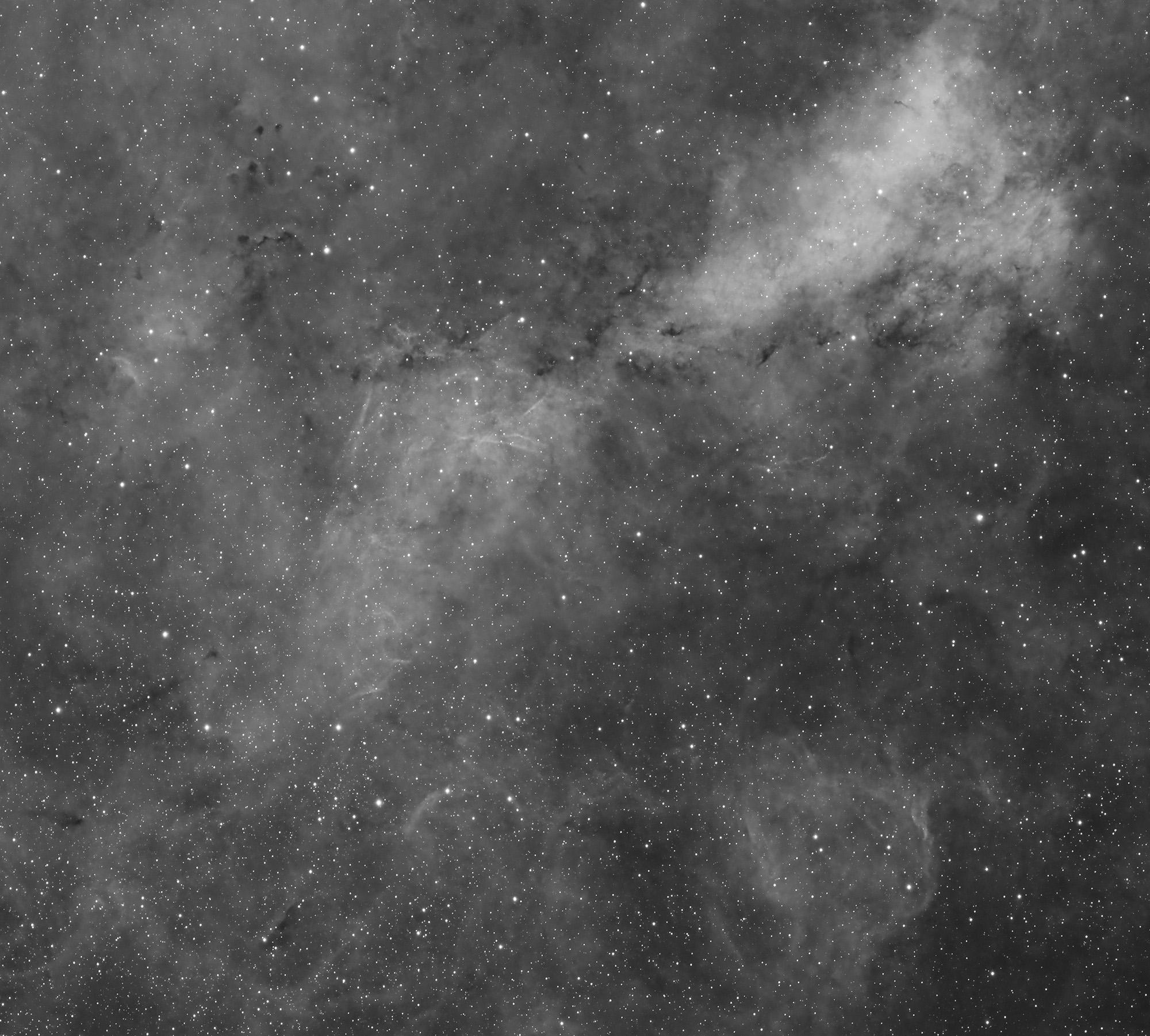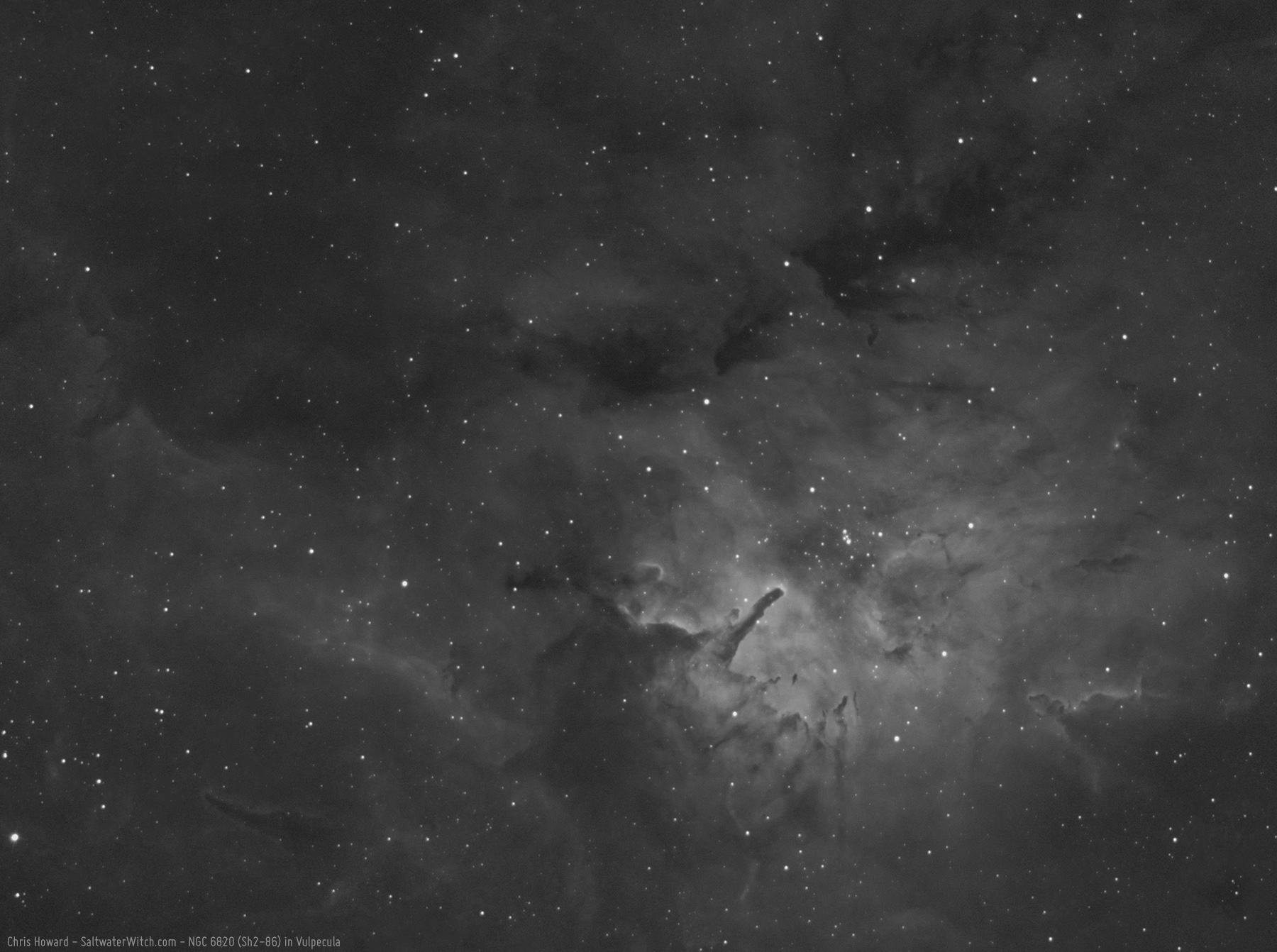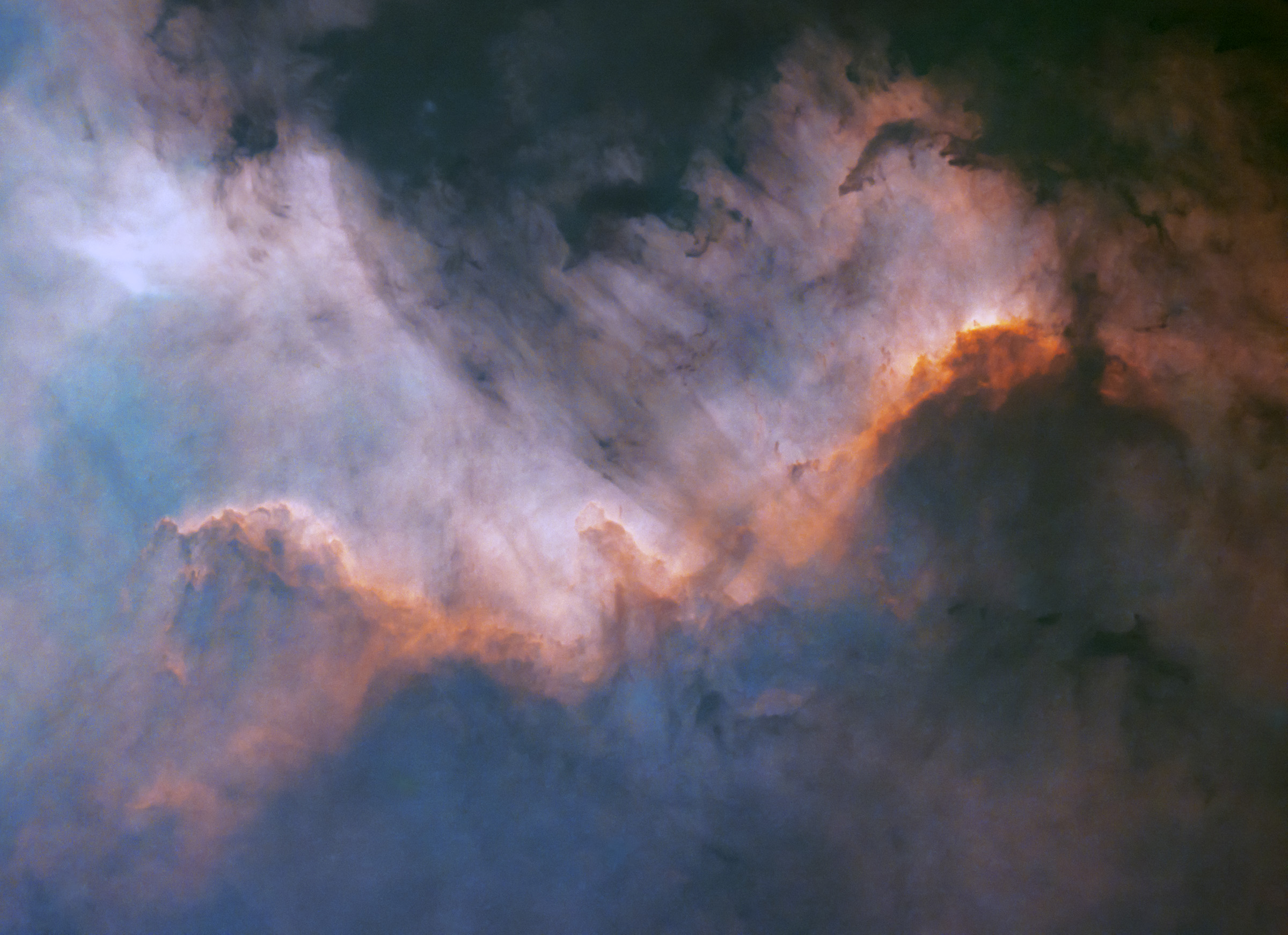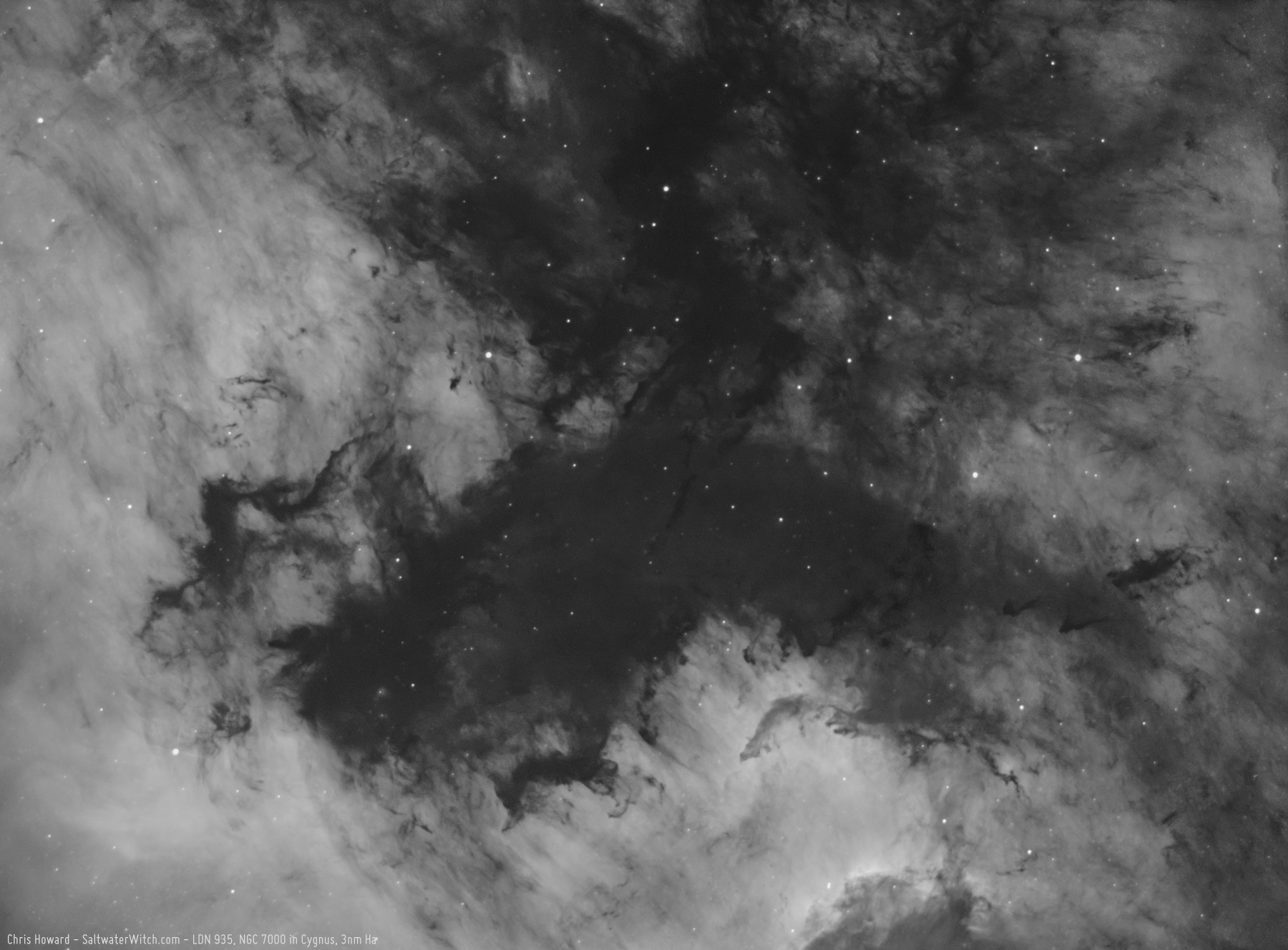Sadr Region (Northeast)
Sadr Region (Northeast) in Cygnus, with a batch of HII regions and dark nebulae, including IC 1318A, LBN 251, DWB 82 (all refer to the large, bright triangular mass at the top right), scattered lumps of dark nebula, including LDN 894, 892, 891, Dobashi 2429, 2468, 2449, et. al. This is probably it for a little while. We have five or six days of rain storms headed our way, and a waxing moon right along with it.

Posted June 23, 2023
Starless NGC 7000 Narrowband
The Cygnus Wall in NGC 7000 (Caldwell 20), the North America Nebula in the constellation Cygnus. These clouds of molecular hydrogen and oxygen are about 2600 lightyears away from us, and to provide some scale, this frame is about a hundred lightyears from one side to the other, or about 600 trillion miles or 950 trillion kilometers. Notes: stars removed with StarNet2 to highlight the softer wisps of dark nebulae scattered in front of the bright emission nebula beyond.
Posted June 12, 2023
Dark Nebulae in Cygnus, 3nm Ha
LDN 935, 933 (dark nebulae), the "Gulf of Mexico" region of NGC 7000, the North America Nebula in Cygnus.
Dark nebula Dobashi 2961, et al. below the North America Nebula, 3 nanometer hydrogen-alpha:

Atlas and Catalog of Dark Clouds Based on the 2 Micron All Sky Survey
Kazuhito Dobashi, Publications of the Astronomical Society of Japan, Volume 63, Issue sp1, 25 January 2011, Pages S1–S362, https://doi.org/10.1093/pasj/63.sp1.S1

Posted May 31, 2023
NGC 6888 without stars
NGC 6888, the Crescent Nebula in Cygnus (stars removed). Apertura 800mm f/4 newtonian, 28 x 300 exposures with the ZWO ASI071MC cooled to -10C, Optolong dual-band l-eXtreme filter with 7nm bandpasses at Ha and OIII, Sky-Watcher EQ6-R Pro mount, William Optics 32mm/120mm FL guide scope + ZWO ASI290MM guide camera. The Crescent is close to 5000 lightyears away, about 25 lightyears across at its widest point, roughly 237 trillion kilometers wide (150 trillion miles). The dense clouds of oxygen and hydrogen are lit up with the intense radiation of a central star; the whole structure is expanding and accelerating away energetically, very bright against the velvety bed of ionized hydrogen that spans most of the constellation Cygnus. With the stars removed from the image, NGC 6888 almost looks solid instead of a vast bubble of interstellar gas and dust.

Posted May 30, 2023
NGC 6820 (Sh2-86) in Vulpecula
Nebula NGC 6820 (Sh2-86) in the constellation Vulpecula, surrounding the open star cluster NGC 6823. 48 x 300-second subs in 3nm Hydrogen-alpha. The intense radiation from that central cluster of stars is hollowing out the nebula, pushing the gas and dust in all directions, creating pillars of trailing material where energetic star light meets dense pockets of gas, or faster cooling heavy elements with higher inertia. Everything in that rough circular area in the bottom right is accelerating away from those bright and very hot stars in the center. I believe the dark nebulae across the middle and top are part of Dobashi 2045? (I really want to know the story with that weird faintly-backlit tail of interstellar dust at the lower left. Definitely something cool going on there).
Interesting info on the formation of pillars and "elephant trunks" in nebulae:
Jonathan Mackey, Andrew J. Lim, Dynamical models for the formation of elephant trunks in H II regions, Monthly Notices of the Royal Astronomical Society, Volume 403, Issue 2, April 2010, Pages 714–730, https://doi.org/10.1111/j.1365-2966.2009.16181.x

Went back last night and captured 48 subs of OIII:

Posted May 29, 2023
NGC 7000 in Cygnus
I bought the Optolong L-eXtreme dual narrowband filter last year, but I haven't seriously used it until last night. Paired with the ZWO ASI071 and the 800mm f/4 Newtonian, I am pleasantly surprised with the data and processed image. The North America Nebula (NGC 7000) in the constellation Cygnus hit 30° above the horizon around midnight, and I spent over 3.5 hours capturing data, 45 x 300-second exposures stacked in DSS. This has to be the most efficient way to get to a bi-color narrowband image, using a single filter and color astronomy camera. These colors are also close to true in terms of where they are on the visible spectrum, with hydrogen-alpha in red and oxygen III in blue.

Posted May 14, 2023
Tangled clouds in Cygnus
There's a lot going on in this detailed look at one tiny section of the vast network of interstellar dust and clouds of hydrogen in the constellation Cygnus, including the open star clusters NGC 6871, NGC 6883 and a handful of dark nebulae including Barnard 147 (LDN 853, the pointy dark channel of dust a little left of center), B146, LDN 856, 858. Notes: 28 x 8-minute exposures, almost four hours of data in hydrogen-alpha (Antlia 3nm Ha Pro filter), William Optics GT81 Apochromatic refractor 382mm FL at f/4.7, ZWO ASI1600MM-Pro mono camera cooled to -10C.

Cygnus Composite - I combined images from two different scopes, all the data for the wide field view (left) came from my William Optics GT81, and I captured the data for the Tulip Nebula (Sh2-101, right) with the Apertura 8"/203mm Newtonian.

Posted November 4, 2022
Narrowband Boogeyman in Orion
Sure, we're a few days late for halloween, but check out the creepiness of the dark molecular cloud LDN1622, the "Boogeyman Nebula" about 500 lightyears away in the constellation Orion, along with a bright lumpy backdrop of nebulosity lit from above by the variable star 56 Orionis. LDN1621 is the dark nebula to the left of the Boogeyman, and the reflection nebula VdB 62 is just to the right. The uneven cloudiness at the top right is a small section of Barnard's Loop (Sh2-276), which may give you an indication of LDN1622's location, on the other side of the Loop from M78, about halfway up one side of Orion. Notes: 36 x 8-minute exposures, almost five hours of data in hydrogen-alpha (Antlia 3nm Ha Pro filter), William Optics GT81 Apochromatic refractor 382mm FL at f/4.7, ZWO ASI1600MM-Pro mono camera cooled to -10C.



